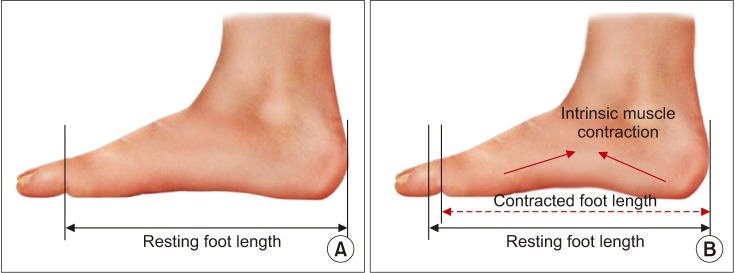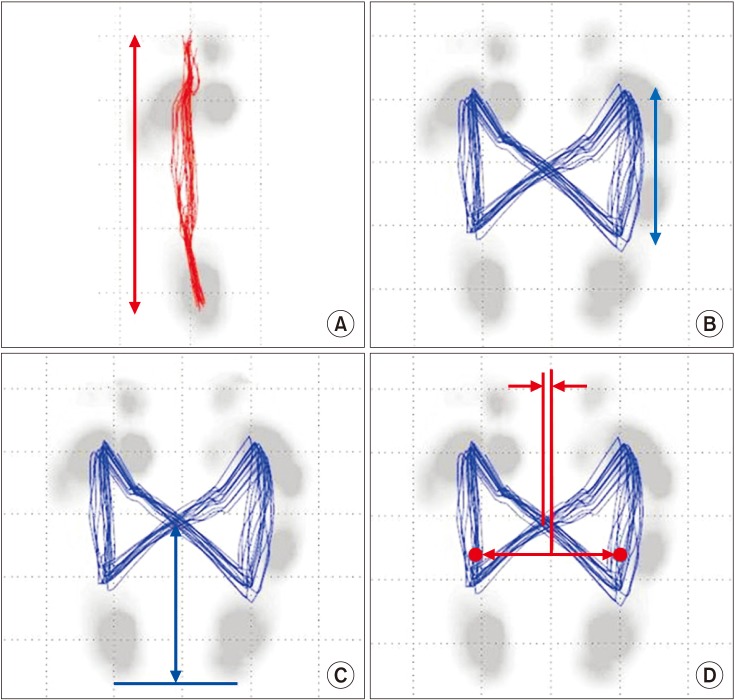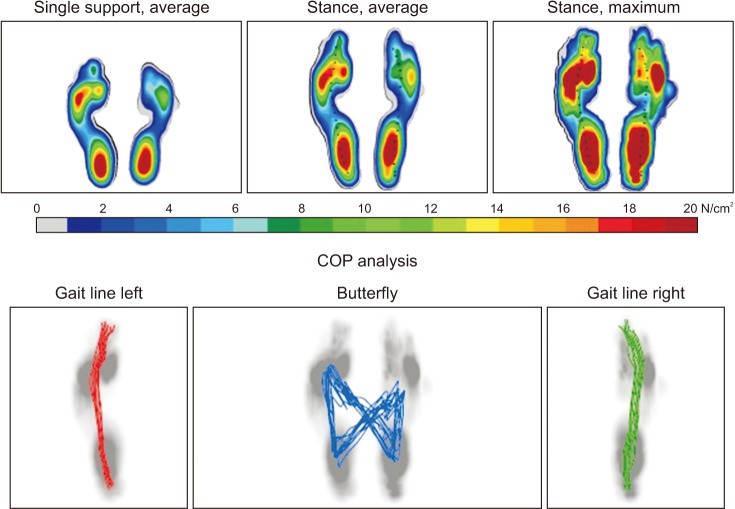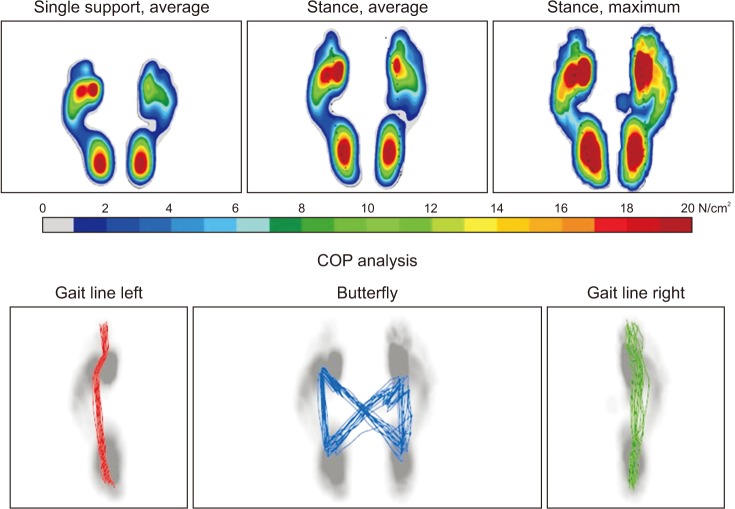Ann Rehabil Med.
2017 Dec;41(6):979-989. 10.5535/arm.2017.41.6.979.
Biomechanical Parameters in Plantar Fasciitis Measured by Gait Analysis System With Pressure Sensor
- Affiliations
-
- 1Department of Physical Medicine and Rehabilitation, Kyung Hee University Hospital at Gangdong, Kyung Hee University School of Medicine, Seoul, Korea. youngloki@naver.com
- 2Department of Physical Medicine and Rehabilitation, Kyung Hee University Medical Center, Seoul, Korea.
- KMID: 2400282
- DOI: http://doi.org/10.5535/arm.2017.41.6.979
Abstract
OBJECTIVE
To investigate the differences in biomechanical parameters measured by gait analysis systems between healthy subjects and subjects with plantar fasciitis (PF), and to compare biomechanical parameters between "˜normal, barefooted' gait and arch building gait in the participants.
METHODS
The researchers evaluated 15 subjects (30 feet) with bilateral foot pain and 15 subjects (15 feet) with unilateral foot pain who had a clinical diagnosis of PF. Additionally, 17 subjects (34 feet) who had no heel pain were recruited. Subjects were excluded if they had a traumatic event, prior surgery or fractures of the lower limbs, a leg length discrepancy of 1 cm or greater, a body mass index greater than 35 kg/m2, or had musculoskeletal disorders. The participants were asked to walk with an arch building gait on a treadmill at 2.3 km/hr for 5 minutes. Various gait parameters were measured.
RESULTS
With the arch building gait, the PF group proved that gait line length and single support line were significantly decreased, and lateral symmetry of the PF group was increased compared to that of the control group. The subjects with bilateral PF displayed significantly increased maximum pressure over the heel and the forefoot during arch building gait. In addition, the subjects with unilateral PF showed significantly increased maximum pressure over the forefoot with arch building gait.
CONCLUSION
The researchers show that various biomechanical differences exist between healthy subjects and those with PF. Employing an arch building gait in patients with PF could be helpful in changing gait patterns to normal biomechanics.
Keyword
MeSH Terms
Figure
Cited by 1 articles
-
Effects of Strengthening and Stretching Exercises on the Temporospatial Gait Parameters in Patients With Plantar Fasciitis: A Randomized Controlled Trial
Suthasinee Thong-On, Sunee Bovonsunthonchai, Roongtiwa Vachalathiti, Warinda Intiravoranont, Sarawut Suwannarat, Richard Smith
Ann Rehabil Med. 2019;43(6):662-676. doi: 10.5535/arm.2019.43.6.662.
Reference
-
1. Goff JD, Crawford R. Diagnosis and treatment of plantar fasciitis. Am Fam Physician. 2011; 84:676–682. PMID: 21916393.2. Karabay N, Toros T, Hurel C. Ultrasonographic evaluation in plantar fasciitis. J Foot Ankle Surg. 2007; 46:442–446. PMID: 17980840.
Article3. Oliveira HA, Jones A, Moreira E, Jennings F, Natour J. Effectiveness of total contact insoles in patients with plantar fasciitis. J Rheumatol. 2015; 42:870–878. PMID: 25774062.
Article4. Irving DB, Cook JL, Young MA, Menz HB. Impact of chronic plantar heel pain on health-related quality of life. J Am Podiatr Med Assoc. 2008; 98:283–289. PMID: 18685048.
Article5. Stuber K, Kristmanson K. Conservative therapy for plantar fasciitis: a narrative review of randomized controlled trials. J Can Chiropr Assoc. 2006; 50:118–133. PMID: 17549177.6. McMillan AM, Landorf KB, Barrett JT, Menz HB, Bird AR. Diagnostic imaging for chronic plantar heel pain: a systematic review and meta-analysis. J Foot Ankle Res. 2009; 2:32. PMID: 19912628.
Article7. Osborne HR, Allison GT. Treatment of plantar fasciitis by LowDye taping and iontophoresis: short term results of a double blinded, randomised, placebo controlled clinical trial of dexamethasone and acetic acid. Br J Sports Med. 2006; 40:545–549. PMID: 16488901.8. Healey K, Chen K. Plantar fasciitis: current diagnostic modalities and treatments. Clin Podiatr Med Surg. 2010; 27:369–380. PMID: 20691370.
Article9. Donley BG, Moore T, Sferra J, Gozdanovic J, Smith R. The efficacy of oral nonsteroidal anti-inflammatory medication (NSAID) in the treatment of plantar fasciitis: a randomized, prospective, placebo-controlled study. Foot Ankle Int. 2007; 28:20–23. PMID: 17257533.
Article10. Hyland MR, Webber-Gaffney A, Cohen L, Lichtman PT. Randomized controlled trial of calcaneal taping, sham taping, and plantar fascia stretching for the short-term management of plantar heel pain. J Orthop Sports Phys Ther. 2006; 36:364–371. PMID: 16776486.
Article11. Roos E, Engstrom M, Soderberg B. Foot orthoses for the treatment of plantar fasciitis. Foot Ankle Int. 2006; 27:606–611. PMID: 16919213.
Article12. Kalaci A, Cakici H, Hapa O, Yanat AN, Dogramaci Y, Sevinc TT. Treatment of plantar fasciitis using four different local injection modalities: a randomized prospective clinical trial. J Am Podiatr Med Assoc. 2009; 99:108–113. PMID: 19299346.13. Thomson CE, Crawford F, Murray GD. The effectiveness of extra corporeal shock wave therapy for plantar heel pain: a systematic review and meta-analysis. BMC Musculoskelet Disord. 2005; 6:19. PMID: 15847689.
Article14. Othman AM, Ragab EM. Endoscopic plantar fasciotomy versus extracorporeal shock wave therapy for treatment of chronic plantar fasciitis. Arch Orthop Trauma Surg. 2010; 130:1343–1347. PMID: 20033696.
Article15. Lynn SK, Padilla RA, Tsang KK. Differences in static- and dynamic-balance task performance after 4 weeks of intrinsic-foot-muscle training: the short-foot exercise versus the towel-curl exercise. J Sport Rehabil. 2012; 21:327–333. PMID: 22715143.
Article16. Wearing SC, Smeathers JE, Yates B, Sullivan PM, Urry SR, Dubois P. Sagittal movement of the medial longitudinal arch is unchanged in plantar fasciitis. Med Sci Sports Exerc. 2004; 36:1761–1767. PMID: 15595298.
Article
- Full Text Links
- Actions
-
Cited
- CITED
-
- Close
- Share
- Similar articles
-
- Biomechanical Factors Associated with Plantar Fasciitis in Non-obese Patients
- Biomechanical Parameters in Arch Building Gait Measured by Gait Analysis System with Pressure Sensor
- Effect of Ankle Foot Orthosis on Hemiplegic Gait
- Insole Pressure Sensors to Assess Post-Stroke Gait
- Dynamic Foot Pressure Measurement in Parkinson's Disease with Foot Scan System





